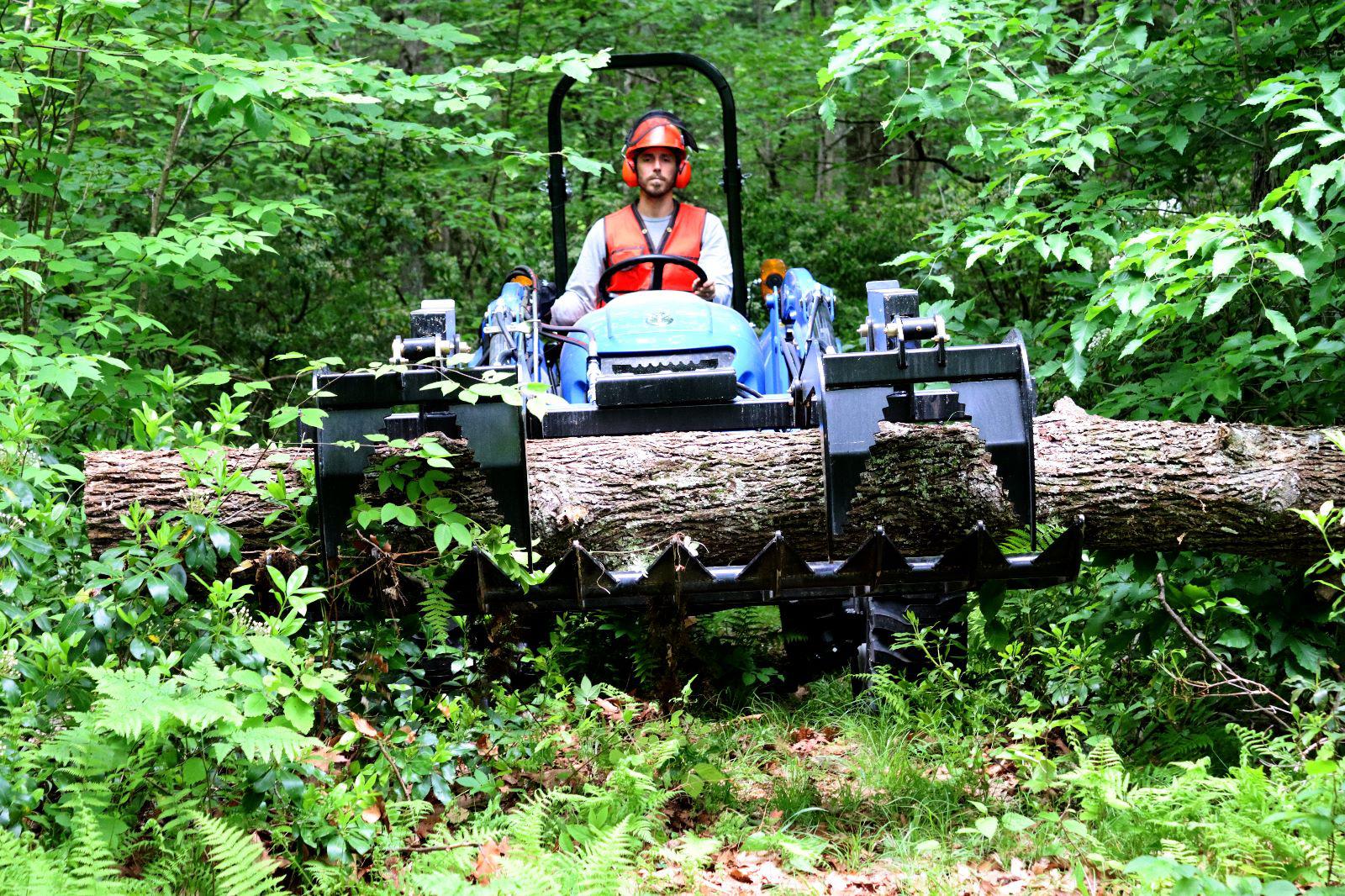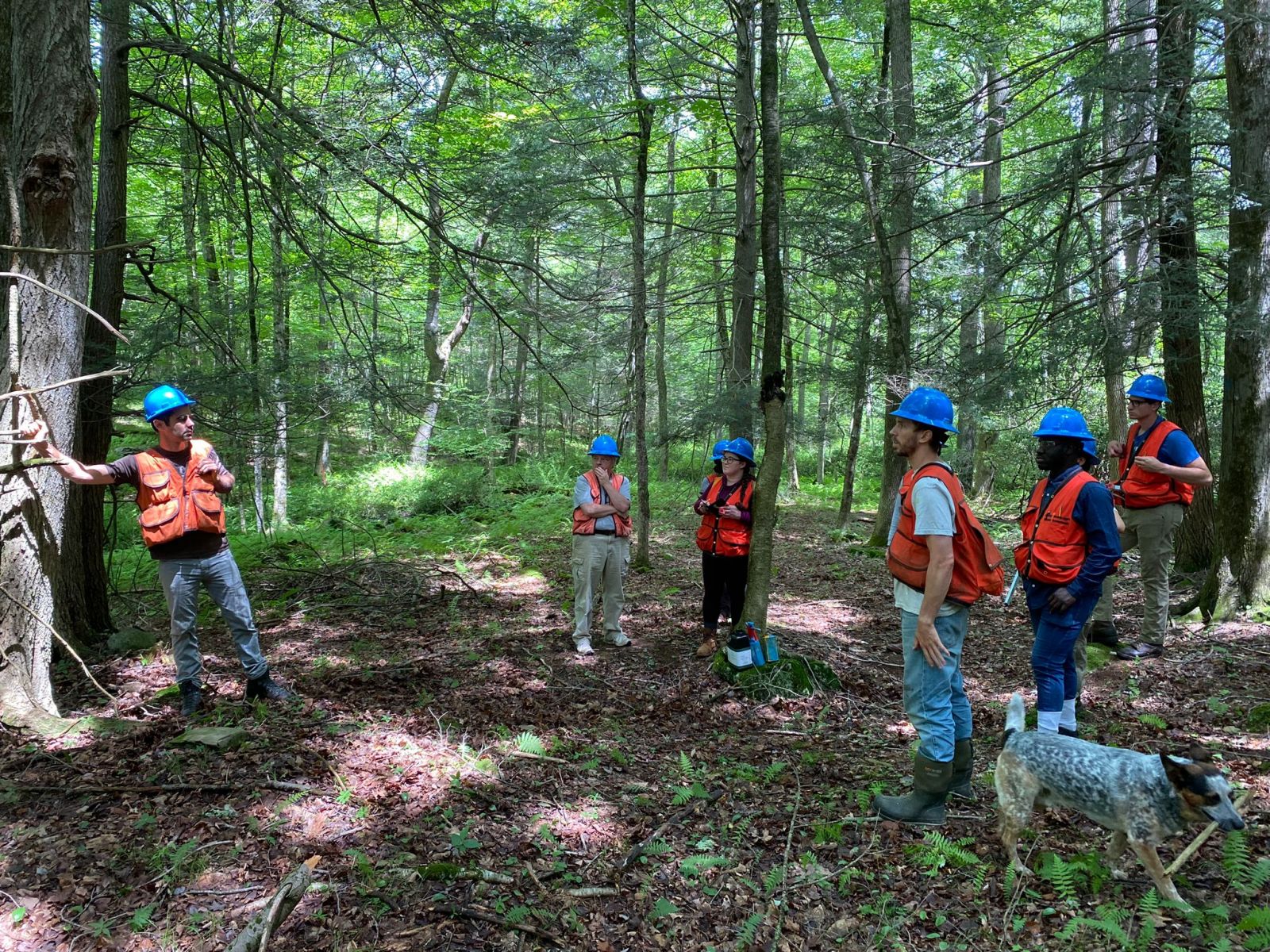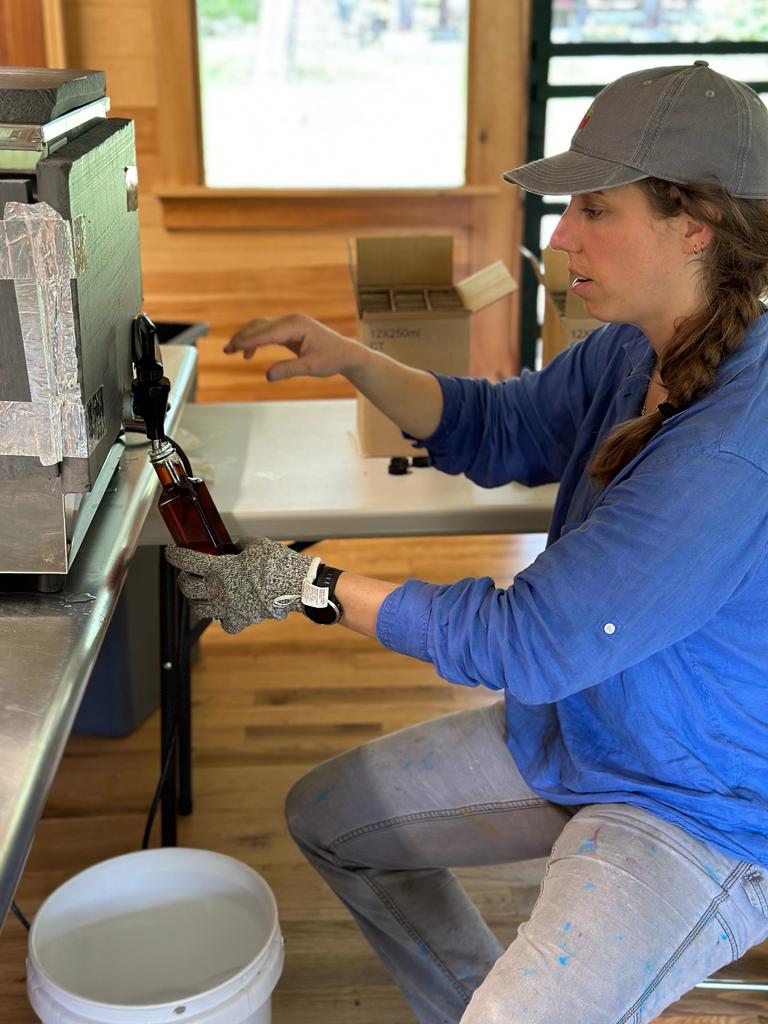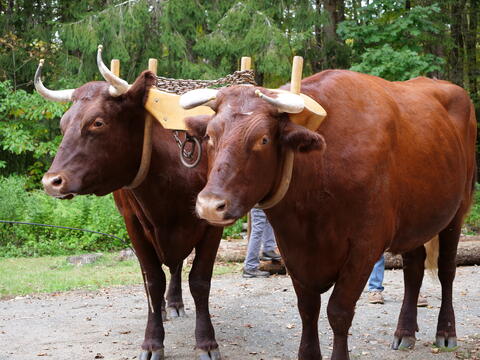
By: Wyatt Klipa ‘23 MEM
Marking paint splatters, soft serve ice cream, multiple tick checks a day, afternoon swims, the crack of an axe through firewood, the scrape of a mattock through gravel and dirt, the sound of laughter echoing through the oak-hickory forests of Northeastern Connecticut.
Each year an intrepid collection of Yale forestry students participates in the long standing and storied Apprentice Forester Program – known colloquially and affectionately as ‘Forest Crew’ by students and faculty. With a history dating back to the 1940s, there have been as many different Forest Crew stories as Forest Crew members, yet the core experience of hands-on forest management has endured.
The Forest Crew program was developed to provide forestry-interested students with a suite of skills and experiences to take their diverse classroom learnings and apply them in the field. The Yale Forests system aims to balance a trio of goals: education, research, and management. Forest Crew members are tasked with making decisions that will help amplify each and set the trajectory for the forest’s future.
This year the Crew consisted of a nine-member cohort. Recently graduated foresters included Fredrick Addai ’23 MF, Grace Bachmann ’23 MF, Chomri Khayi ’23 MF, Wyatt Klipa ’23 MEM, and Lauryn Sherman ’23 MF. Meanwhile, four members joined the Crew between their first and second year of their graduate program: Amelia Napper ’24 MF, Austin Pruitt ’24 MF, Hayden Stebbens ’24 MF, and Zane Weinberger ’24 MF.
The summer got off to a quick start as the Crew travelled to Yale-Myers Forest in Eastford, Connecticut, and moved into their summer accommodations just two days after Yale’s commencement. Arriving late on a sunny May morning, crew members slowly settled into their rooms at the Yale-Myers Forest Camp, identifying the ideal bunk to be their home for the next twelve weeks. As the afternoon wore on, the Crew gathered with Mark Ashton, Morris K. Jesup Professor of Silviculture and Forest Ecology and director of Yale Forests, to receive an orientation to camp and summer.
The first full days of the field season were some of the most nerve-wracking, as members dove into the deep end of working in the forest, learning proper chainsaw safety through the Game of Logging program. Splitting into two teams, each group spent a day out in the forest’s soon-to-be-expanded sugarbush learning how to properly direct a falling tree and time the fall to ensure the safety of the logger. Bachmann and Weinberger both had prior experience working on Western fire crews and extended their knowledge to others, while most other crew members successfully felled their inaugural tree.
Hayden Stebbens ‘24 MF removes logs from a tree that crew members cut to expand the sugarbush. The logs became firewood used in the maple syrup production process. June 5, 2023. Photo: Fredrick Addai.
The summer ramped up after Memorial Day weekend. The first responsibility was road maintenance. The Crew checked the status of thirteen different forest roads throughout Yale-Myers. Splitting into small teams they worked on improving water bars, digging drainage ditches, and clearing fallen woody debris while dodging extreme heat and thunderstorms. It was imperative to keep these roads clear and in good condition to allow for access for research and forest operations.
Each year, Forest Crew is assigned to focus on one of YMF’s eight different management divisions on a rotating schedule. The Crew of 2023 managed the Curtis Division, a 1,247 acre parcel of forestland conveniently located immediately west of the Yale-Myers Forest Camp mostly consisting of alternating ridge-valley topography. Crew members traversed the division from dry oak-hickory ridge tops to mesic sugar maple, ash, and hemlock slopes to wet valley bottoms with vernal pools and wetlands. To orient themselves with the division, the Crew began by walking the property boundaries, recording inconsistencies, and refreshing boundary markers.
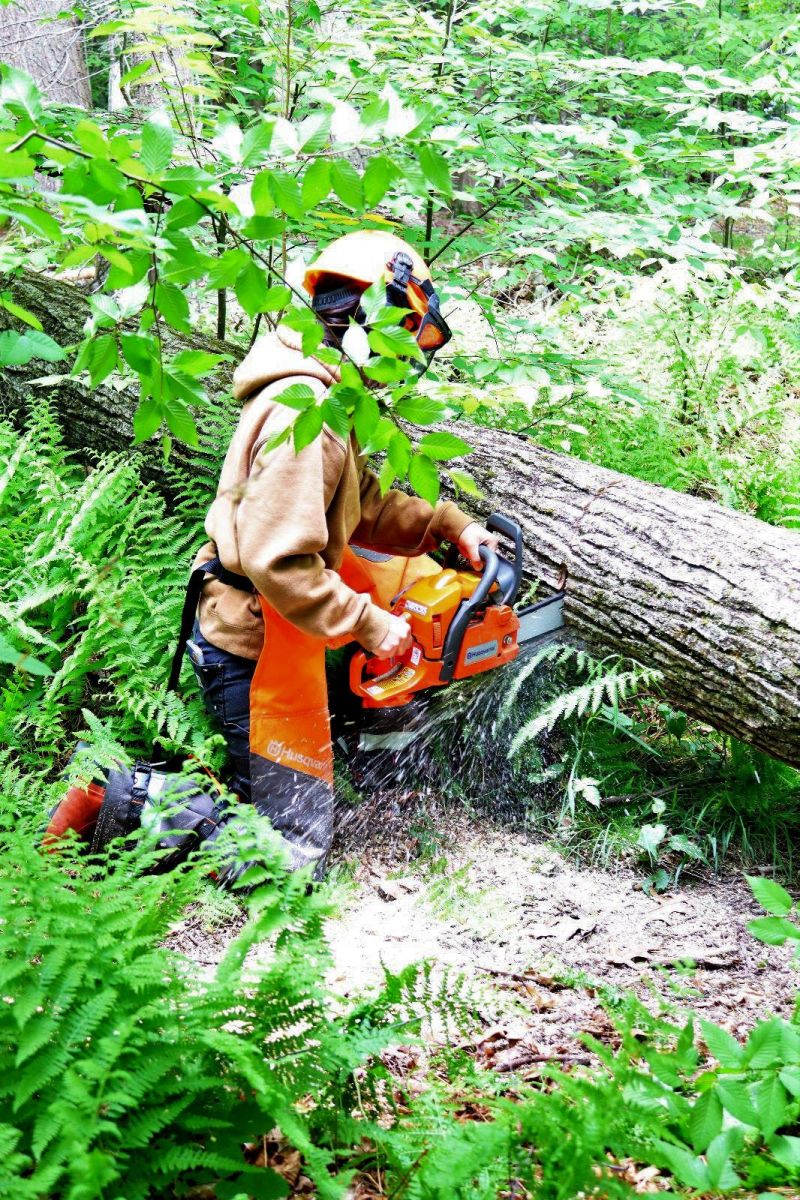
Amelia Napper ‘24 MF uses a chainsaw to clear a fallen tree from a road at Yale-Myers Forest on June 5, 2023. Crew members are responsible for maintaining Yale-Myers’ thirteen forest roads for research access and forest operations. Photo: Fredrick Addai.
In addition to field experiences, more structured learning opportunities were abundant through the early portion of the summer. Ashton presented a combination of lectures and field tours about the land use history, surficial geology, soil types, and bird species of Southern New England. Marlyse Duguid, Thomas J. Siccama Senior Lecturer in Field Ecology, gave a crash course on plant identification, guiding the Crew and resident researchers – also spending their summer at the forest camp – through a tour of trees and herbaceous ground cover species. Finally, later in June, Joseph Orefice, lecturer and director of forest and agricultural operations at Yale Forests, gave a lecture on sampling design for forest inventory. The Crew then developed a sampling design that would enable them to achieve the mammoth task of inventorying their nearly 1,300 acres of forest in a week.
Using a combination of variable radius plots and qualitative regeneration data, the Crew cruised the Curtis Division and sampled over 350 plots with thickets of mountain laurel, surprise wetland passages, and a rather hungry tick population unable to slow them down. They then compiled, analyzed, and presented their data to Ashton and Orefice. The goal was to identify suitable stands for two types of treatments: thinning and regeneration.
After much deliberation, the Crew chose two sections of the Curtis Division where silvicultural treatments would be both ecologically beneficial and commercially viable. For both areas, the Crew identified a complex of neighboring stands where at least one stand could benefit from a thinning treatment while the other was ready for regeneration. The Crew determined that several stands would be well suited to a crown thinning, which entails marking dominant and codominant individuals with poorer growth forms for removal to open canopy space and growing room for more well-formed individuals – often oak or hickory.
Throughout their thinning operations the Crew had to make difficult decisions considering the fate of the white ash (Fraxinus americana) growing in the canopy. Emerald ash borer (EAB) is already impacting white ash throughout the forest. Crew members observed numerous mature ash expressing signs of canopy dieback, epicormic sprouting, and blonding on the bark left behind as woodpeckers eat the nonnative insects. Some ash were healthy at the time of marking, but EAB is ever encroaching. Crew members had to choose between removing a healthy ash to prioritize the growth of the trees around it or maintaining the ash and running the risk that it would die from EAB in the near future. It was impossible to be certain, and these dilemmas challenged the Crew throughout their thinning operation, resulting in deep discussion and reflection on how to manage a forest most effectively in a world with a rapidly changing climate and shifting insect and pathogen dynamics.
Joseph Orefice (left) and Mark Ashton (next from left) instruct the Forest Crew on guidelines for marking a crown thinning in the Curtis Division of the Yale-Myers Forest on June 29, 2023. Photo: Grace Bachmann.
In two other Curtis Division stands, the Crew determined that an irregular shelterwood regeneration system would benefit the forest. Through an irregular shelterwood, the Crew aimed to remove most mature trees from the stand to create more space and sunlight to naturally regenerate shade-intolerant species. The Crew varied their spacing and structure due to the variability of the stands treated, with smaller gaps left in more xeric – or dry – oak-hickory ridges and larger gaps opened in more mesic areas where sugar maple and ash were common and growing space would be more competitive. By regenerating mature stands, the Crew aimed to promote greater landscape heterogeneity and successional diversity at the forest scale while also providing economic power to future Yale Forest operations. The impacts of these silvicultural operations are also the focus of research at Yale-Myers.
Throughout the summer the Crew formed tight professional and personal bonds with one another. Evenings were marked by trail runs, trips to get ice cream, swims in nearby Mashapaug Lake, rousing games of volleyball against the researchers, and hangouts in the Crew’s barn office-become-clubhouse. Members attended the biweekly summer seminar series hosted at the camp, where they met neighboring landowners and learned of current forestry and ecology research relevant to Connecticut’s Quiet Corner. Each element of the summer led to an experience truly steeped in place.
As July turned to August and the days grew slowly shorter, the Crew engaged in two final unique experiences. First, the Crew was tasked with helping to mark another thinning operation, this time to expand Yale-Myers’ nascent sugar maple enterprise. Not only did members help expand the sugarbush, contributing to increased maple syrup production, but they also bottled ten cases of Yale-Myers maple syrup. Through this experience, the Crew played a significant role in both the initiation and completion of the forest’s maple syrup production process.
Grace Bachmann ‘23 MF bottles maple syrup produced entirely within Yale-Myers Forest on August 2, 2023. Crew members bottled ten cases of syrup which will be sold over the next year. Photo: Fredrick Addai.
Second, the Crew dedicated their final two weeks to Yale’s Toumey Forest in Keene, New Hampshire. Toumey was Yale’s first forest and has been part of the school for over 100 years. While staying together in rustic accommodations at the somewhat misleadingly named “Toumey Villa,” the Crew wrapped up their season by marking boundaries and inventorying the stands in Toumey’s Base Hill division.
The season culminated in New Hampshire, as Ashton and Orefice met the crew members in Keene to congratulate them on a summer well done. The Crew paid their respects with a toast at the grave of the forest’s namesake, James W. Toumey, former Morris K. Jesup Professor of Silviculture and second Dean of the Yale School of Forestry. Then Ashton and Orefice honored the Crew with certificates of completion of the Apprentice Forester program and their own forester’s suspenders, two keepsake reminders of an incredible summer of challenges, laughter, and learning.
